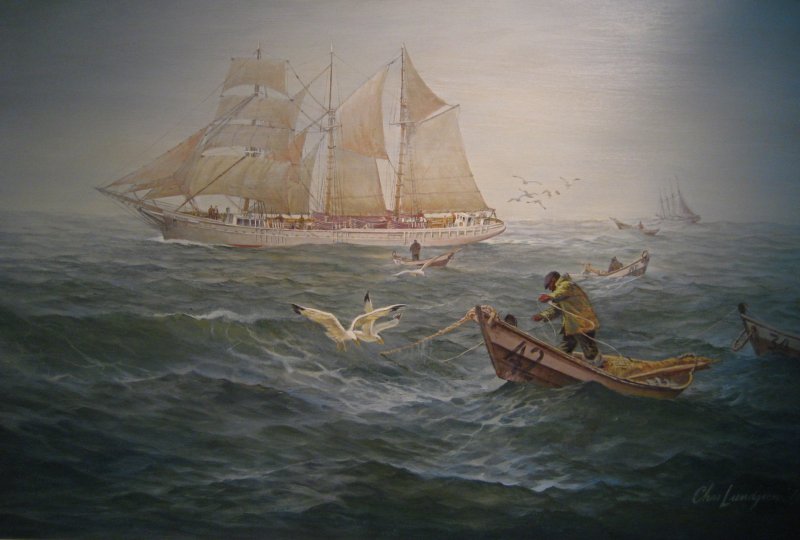








2/22/17
 The barquentine Gazela Primeiro (meaning Gazelle the First in Portuguese) was built in the shipyard of J. M. Mendes in Setúbal, Portugal in 1901. At that time the Portuguese fisheries authorities had a regulation prohibiting the construction of new vessels for the Grand Banks cod fishery. It was however permissible to modify or "rebuild" an existing vessel. The best information available indicates that the registration of a much smaller, two-masted vessel built in Cahilas in 1883, named Gazella (spelled with two Ls), was transferred by the owners to the newly built vessel in 1901. There is no evidence that any timbers from the earlier vessel were re-used in the construction of the later one; a practice which would make no sense to a commercial wooden shipbuilder in 1901. Gazela was built to carry fishermen to the Grand Banks of Newfoundland. Every spring she would leave Lisbon, laden with as many as 35 dories stacked on deck like drinking cups, a crew of 40 men (35 fishermen/sailors, two cooks, two mates and the captain), and a couple of apprentices. Her cargo hold would be full of salt as ballast. The salt would be used for the fish that were caught (cod, flounder, halibut, haddock and perch), preserving them for the long trip home. The Gazela could stow upwards of 350 tons of salted fish in her holds. Gazela was engine-less until 1938, when a Mannheim-Benz diesel engine was installed. With the depletion of cod on the Grand Banks, vessels were being forced to fish the Davis Strait, between Greenland and Newfoundland. The contrary winds and frequent icebergs in this area made life difficult for ships without engines. To accommodate the propeller, a new rudder post was installed and her counter was extended approximately 10–12 feet, giving her a long overhanging transom. After a remarkably long commercial career, Gazela's last voyage to the Banks as a commercial fishing ship was made in 1969. About the time Gazela was laid-up after her final voyage to the Banks, the Philadelphia Maritime Museum was searching for an historic sailing vessel. Word reached Gazela's owners and the following year, she was purchased for the museum by philanthropist William Wikoff Smith. On May 24, 1971, with a crew of Americans (including one former Gazela engineer), the ship left for its new home in Philadelphia, tracing Columbus' route via the Canary Islands and San Juan, Puerto Rico and on Thursday, July 8, made her first entrance into Philadelphia. In 1985, Gazela was transferred to the Philadelphia Ship Preservation Guild, the not-for-profit corporation that now maintains and operates the vessel with the help of donors and volunteers, sending her as Philadelphia's tall ship to events up and down the eastern seaboard of the U.S. Gazela spends the spring and summer months cruising the Delaware River and the Atlantic Coast. In the winter months the Gazela is maintained by volunteer members of the Philadelphia Ship Preservation Guild.
|
||
 Specifications:
Specifications: